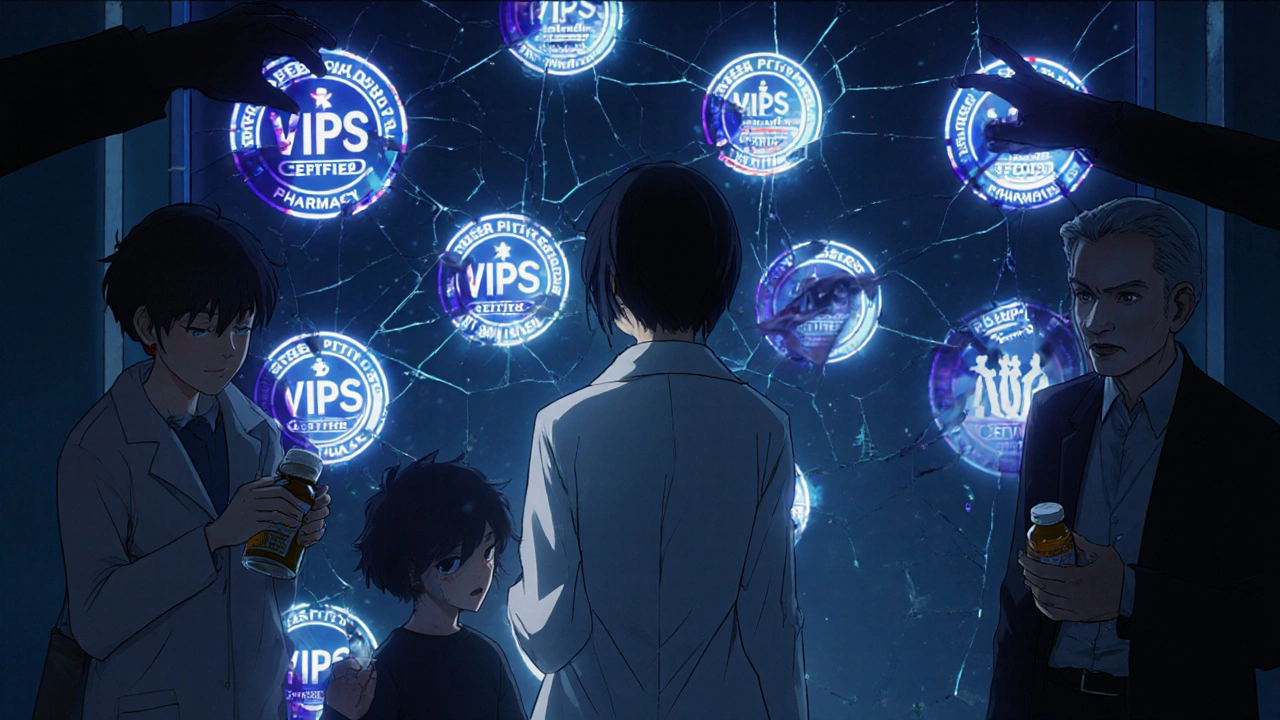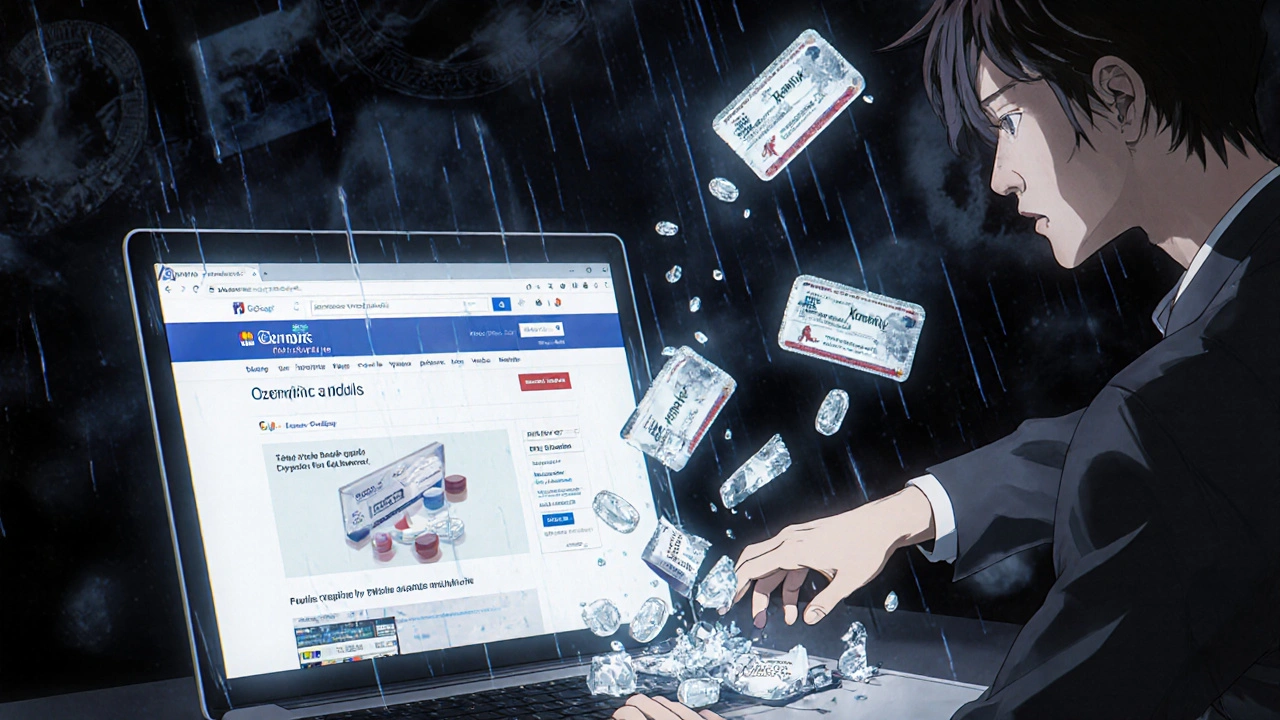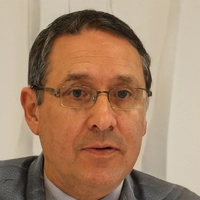Every year, millions of people turn to online pharmacies for convenience, lower prices, or privacy. But behind the polished websites and tempting discounts lies a dangerous reality: online pharmacy counterfeits are killing people. These aren’t just fake pills with the wrong label-they’re lethal mixtures of fentanyl, rat poison, chalk, or nothing at all. And they’re easier to find than you think.
How Fake Medicines Are Sold Online
Illicit online pharmacies don’t look like criminal operations. They look like Amazon. Professional logos, secure checkout pages, customer reviews, even live chat support. Some even mimic the exact layout of real pharmacy sites like CVS or Walgreens. Criminals register domains with slight misspellings-pharmacy24.com instead of pharmacy247.com-and use ads on Google, Facebook, and Instagram to drive traffic. These sites sell prescription drugs without requiring a prescription. Need Ozempic? Botox? Xanax? Just click. No doctor’s visit. No blood tests. No conversation about your health. The FDA confirmed in June 2025 that counterfeit alli (orlistat) capsules were being sold on U.S.-based online retailers. In April 2024, fake Botox was found in multiple states. And in 2023, counterfeit Ozempic was discovered in over a dozen states. These aren’t isolated cases-they’re the norm. According to the National Association of Boards of Pharmacy, 95% of websites selling prescription drugs online operate illegally. The U.S. Trade Representative’s 2024 report found that 96% of the 35,000 online pharmacies worldwide break the law. That means if you’re buying medication online without checking credentials, you’re almost certainly buying from a criminal operation.What’s Actually in Those Pills?
Counterfeit drugs don’t just lack the right ingredients-they often contain deadly ones. The DEA seized over 60 million fake pills laced with fentanyl in 2024. A single pill can contain enough fentanyl to kill an adult. That’s 50 times stronger than heroin. People think they’re buying Adderall for focus or Xanax for anxiety. Instead, they’re ingesting a synthetic opioid they didn’t ask for. In other cases, counterfeit diabetes meds contain no metformin at all-just sugar and fillers. Patients keep taking them, their blood sugar stays high, and they end up in the hospital with complications. Fake antibiotics might have the wrong dose, letting infections spread instead of healing them. Some counterfeit cancer drugs contain toxic chemicals that damage organs. The World Health Organization estimates that 1 in 10 medicines in low- and middle-income countries are fake. But this isn’t just a problem overseas. In the U.S., counterfeit drugs are flooding the market because online sellers operate from countries with weak enforcement-China, India, Turkey, and others. The OECD reports that nearly 38% of all seized counterfeit medicines are branded by U.S. pharmaceutical companies, meaning American consumers are being targeted by fake versions of their own trusted drugs.Who’s Buying and Why
People aren’t buying fake medicines because they’re reckless. They’re buying them because they’re desperate. Ozempic costs over $1,000 a month without insurance. Botox injections run $500-$1,000 per session. Many patients can’t afford these treatments, so they turn to the internet for cheaper options. A website offering Ozempic for $99 a month sounds like a miracle. But that miracle is a death sentence. The same goes for painkillers. People with chronic pain, afraid of being labeled as addicts, avoid doctors and buy pills online. They don’t realize they’re risking overdose. The CDC explicitly warns that people ordering medications from illegal online pharmacies are at risk for overdose from fentanyl-laced pills. In 2024, the DOJ indicted 18 people for running online pharmacies that distributed millions of these fake pills to tens of thousands of Americans. Even over-the-counter drugs aren’t safe. Fake alli (orlistat) capsules-marketed for weight loss-were found to contain no active ingredient. People lost money and gained nothing. Others reported severe stomach pain after taking them.
How to Spot a Legit Online Pharmacy
Not all online pharmacies are dangerous. But you need to know how to tell the difference. The FDA’s BeSafeRx program gives you three simple rules:- Require a valid prescription from a licensed doctor
- Have a licensed pharmacist on staff who can answer your questions
- Be physically located in the U.S. and display a verifiable street address
- Sell prescription drugs without a prescription
- Offer “miracle cures” or drugs not approved in the U.S.
- Have no physical address or only a P.O. box
- Use “free shipping” or “50% off” as their main selling point
- Ask for payment only in cryptocurrency or wire transfer
The Real Cost of Saving a Few Dollars
It’s tempting to think, “What’s the worst that could happen?” But the answer is simple: death. In 2024, the Pharmaceutical Security Institute recorded 6,424 global incidents of counterfeit medicine distribution. Over 2,400 different drugs were affected-everything from insulin to heart medication to antidepressants. Criminals aren’t just making money-they’re playing Russian roulette with your life. One woman in Ohio bought fake Ozempic online for $120 a month. She lost 15 pounds in three weeks. She thought it was working. Then she collapsed. She was rushed to the hospital with kidney failure. Tests showed her blood contained traces of heavy metals and an unknown chemical. She survived. Others haven’t. The WHO estimates that countries spend $30.5 billion a year on fake or substandard medicines. That’s not just wasted money-it’s lost time, lost health, and lost lives. And for every pill seized by law enforcement, thousands more are still in circulation.
What to Do If You’ve Bought Fake Medicine
If you’ve taken a medication from an unverified online source and feel unwell, seek medical help immediately. Tell your doctor you suspect counterfeit drugs. Report the pharmacy to the FDA:- Email: [email protected]
- Phone: 855-543-3784 or 301-796-3400
- File an adverse event report through MedWatch
How to Stay Safe Moving Forward
Your health isn’t worth the risk of a $50 discount. Here’s how to protect yourself:- Always get prescriptions from a licensed provider, even if you’re buying online
- Use only VIPPS-certified pharmacies
- Ask your pharmacist if they can verify the source of your medication
- Be suspicious of deals that seem too good to be true-especially for high-demand drugs like Ozempic, Botox, or Adderall
- Teach older family members how to spot fake sites-they’re the most targeted group
Can I trust online pharmacies that are based in Canada?
Not automatically. While Canada has stricter drug regulations than many countries, many websites claiming to be Canadian pharmacies are actually based in other countries and ship from there. The FDA warns that even pharmacies advertising as Canadian often don’t follow Canadian laws. Always check for the VIPPS seal or verify through the Canadian International Pharmacy Association (CIPA) if you’re considering a Canadian site.
Are generic drugs from online pharmacies safe?
Generic drugs are safe when bought from licensed, verified pharmacies. The problem isn’t generics-it’s counterfeit versions of generics. Fake versions of metformin, lisinopril, or atorvastatin are common. Always confirm the pharmacy is accredited and the drug has proper labeling with the manufacturer’s name and lot number. If the packaging looks off, skip it.
Why do counterfeiters target drugs like Ozempic and Botox?
Because they’re expensive, in high demand, and easy to replicate. Ozempic costs over $1,000 a month, so people are desperate for cheaper options. Botox is popular for cosmetic use, and many buyers don’t want to go through a doctor. Counterfeiters know this and exploit it. They make pills or vials that look real, sell them at 80% off, and make huge profits. The profit margin on fake Ozempic can be over 1,000%.
Can I get in trouble for buying counterfeit drugs online?
Generally, no-if you’re a buyer, not a seller. Law enforcement targets the distributors, not the customers. But you’re putting yourself at serious risk. If you take a counterfeit drug and suffer harm, you may have no legal recourse. And if the drug contains illegal substances like fentanyl, you could be exposed to criminal investigation, even if you didn’t know what you were taking.
What’s being done to stop this?
Global efforts are increasing. Interpol’s Operation Pangea XVI in 2025 shut down 13,000 websites and made 769 arrests across 90 countries. The FDA is enforcing the Drug Supply Chain Security Act, which requires electronic tracking of drugs from manufacturer to pharmacy. The DEA is running the “One Pill Can Kill” campaign to raise awareness. But the problem grows faster than enforcement. More public awareness and stricter penalties for sellers are still needed.



9 Comments
Andy Louis-Charles
November 24, 2025 AT 08:43Just saw a post on Reddit where someone bought 'Ozempic' for $89 and ended up in the ER with kidney damage. The pills were just powdered sugar and fentanyl. 🤢
Don't let the pretty website fool you. If it's too cheap, it's poison.
Akash Chopda
November 25, 2025 AT 01:00Theyre all fake anyway the government controls the supply chain so they can sell you the real stuff at 10x price and then blame the internet for your problems
Sam Jepsen
November 25, 2025 AT 20:04Hey everyone - I get it. Medications are expensive. I’ve been there. But please don’t risk your life for a discount.
I work in community health and I’ve seen too many people come in with organ damage from fake meds. One guy thought he was buying generic Adderall - turned out it was industrial-grade meth. He’s lucky he’s alive.
If you can’t afford your meds, talk to your doctor. There are patient assistance programs. Pharmacies have discount cards. Even big chains like CVS have $4 generic lists.
You’re not alone. There’s help. But buying from sketchy sites? That’s not saving money. That’s gambling with your heartbeat.
Yvonne Franklin
November 26, 2025 AT 14:19VIPPS seal is your best friend
Click it or skip it
Bartholemy Tuite
November 27, 2025 AT 17:41Look I’m Irish so I’ve seen my share of dodgy pharmacies but this is next level
Back home you could get a bottle of cough syrup without a script and no one cared but this? This is like buying a car off a guy in an alley who says it’s a BMW but the engine’s made of lego
And the worst part? The people selling this stuff aren’t some shadowy syndicate - they’re just dudes with laptops in Manila or Mumbai running ads on Instagram targeting people who just lost their job and can’t afford insulin
And yeah I know the FDA and Interpol are trying but let’s be real - if you can buy a fake Rolex with a 24-hour delivery, you can buy fake Ozempic too
It’s capitalism with a side of death
And don’t even get me started on how they use AI to clone legit pharmacy sites now - the logos look identical, the checkout feels real, the testimonials are all bots - you’d have to be a forensic accountant to spot the difference
So yeah - don’t be a hero. Don’t be a saver. Be a survivor. And if you’re unsure? Walk away. Your future self will thank you.
Neoma Geoghegan
November 29, 2025 AT 03:53Check CIPA if it’s Canadian
Verify VIPPS
Never skip the pharmacist call
Period
Victoria Stanley
November 30, 2025 AT 01:36Thank you for writing this. I’m a nurse and I’ve had patients show up with blister packs from sites that looked like CVS. One woman thought she was getting Botox - it was saline with trace heavy metals. She had facial paralysis for months.
If you’re reading this and thinking ‘but I’ve never had a problem’ - you’re just lucky so far. Fake meds don’t always hit you right away. Sometimes the damage is slow. Liver. Kidneys. Heart. It creeps in.
Please don’t wait until you’re in the ICU to learn this lesson. Talk to your doctor. Ask about financial aid. Use GoodRx. Call your pharmacy. There are options that don’t involve risking your life.
steven patiño palacio
December 1, 2025 AT 04:05Counterfeit pharmaceuticals are a global public health crisis that disproportionately affects vulnerable populations. The lack of regulatory oversight in international supply chains, combined with algorithm-driven ad targeting, creates a perfect storm for exploitation. The FDA’s BeSafeRx guidelines are not suggestions - they are evidence-based safeguards that have prevented thousands of adverse events. Always verify the physical address, licensing, and accreditation before purchasing. Your life is not a discount coupon.
stephanie Hill
December 2, 2025 AT 06:55They’re all in on it. The FDA, the pharma giants, the ‘trusted’ websites - they want you hooked on overpriced pills so you keep coming back. The ‘fake’ ones? They’re just the ones they didn’t approve. You think Ozempic costs $1,000 because of R&D? Nah. It’s because they own the monopoly. The ‘counterfeit’ pills? Probably the real stuff, just sold by someone who doesn’t pay their taxes. But hey - if you wanna believe the government’s ‘One Pill Can Kill’ campaign, go ahead. They’ll tell you what to fear while they sell you the cure at 1000% markup. 🤷♀️